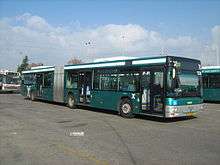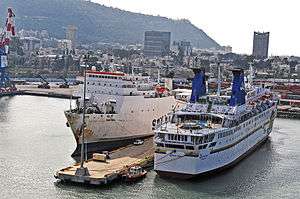Transport in Israel
Transportation in Israel is based mainly on private motor vehicles and bus service and an expanding railway network. Demands of population growth, political factors, the Israel Defense Forces, tourism and increased traffic set the pace. All facets of transportation in Israel are under the supervision of the Ministry of Transport and Road Safety.
Roads

Israel's road network spans 18,096 kilometers (11,244 mi) of roads,[1] of which 449 km (279 mi) are classified as freeways.[2] The network spans the whole country.
Route 6, the Trans Israel Highway, starts just east of Haifa down to the outskirts of Beer Sheva, about 200 km (120 mi). Route 1 between Jerusalem and Tel Aviv and Route 2 between Tel Aviv and Haifa are well maintained highways.
Bus service

Buses are the country's main form of public transport. In 2015, bus passenger trips totaled approximately 678 million.[3] In 2009, 16 companies operated buses for public transport, totaling 5,939 buses and 8,470 drivers. Egged is Israel's largest bus company, and operates routes throughout the country.[4] Bus routes in some areas are operated by smaller carriers, the largest being the Dan Bus Company, operating routes in Gush Dan. Kavim is the next largest.
Bus stations in Israel, other than standalone bus stops, come in two types: terminals (masof, pl. mesofim) and central stations (tahana merkazit). Each terminal serves a number of routes, usually over a dozen, while a central station may serve over a hundred bus routes. The largest central bus terminal in the country is the Tel Aviv Central Bus Station, which is also the second largest bus terminal in the world.
Israel also has a share taxi service (Hebrew - Sherut), run by several private companies, depending on location, in addition to regular taxicab services. The shared sherut service usually appears a yellow minivans and travel along the same path as the normal buses with identical route numbers. For a slightly higher price, the shared sherut service allows passengers to both hop on and hop off anyway along the path of travel. During peak travel, often the time of travel can be shortened as the number of passengers is significantly small compared to normal bus services. Some routes continue to travel through the night and on Shabbat providing transport needs to the population when normal buses services cease. The beginning and end of the sherut vans may differ from the Tachana Makazit and on the weekends and evenings, the routes can also be altered for some services.
On August 5, 2010, the Ministry of Transport opened a website that contained information about public bus and train routes in the country.[5] Previously, information was given only by the individual public transit operators.[6]
Bus rapid transit
Israel has one bus rapid transit system in Haifa, called the Metronit, which consists of three lines connecting Haifa to its suburbs. In addition, there are BRT feeder lines to the Jerusalem Light Rail, running on dedicated bus lanes from Southern Jerusalem to the Northern Jerusalem neighborhood of Ramot crossing the light rail line at the intersection of Jaffa and King George Streets.
Train service

- Total: 1,138 km[7] 1,435 mm (4 ft 8 1⁄2 in) (standard gauge). In 2013 there were over 45 million passenger rides taken.
Many of Israel's railway lines were constructed before the founding of the state during Ottoman and British rule. The first line was the Jaffa–Jerusalem railway, followed by the Jezreel Valley railway, which formed part of the greater Hejaz railway. World War I brought the creation of multiple new lines out of military needs: Portions of what is now the Coastal railway were built simultaneously by the Turkish and British and later merged during the British Mandate. Southern lines were also built by the warring states—from the north by the Ottomans, and from Rafah in the west by the British.
Beginning in the mid-1960s, railway development stagnated, and a number of lines (notably, the Jezreel Valley railway and most of the Eastern railway) were abandoned altogether. Development restarted in the 1990s, the opening of Tel Aviv's Ayalon railway in 1993 signaling a new era of rail development. Lines under construction in the 2000s include the high-speed railway to Jerusalem, an extension of the coastal railway directly from Tel Aviv to Ashdod through the northern Shephelah, and a line from Ashkelon to Beersheba via Sderot, Netivot and Ofakim, as well as a complete reconstruction of the line from Lod to Beersheba. These and other extensive infrastructure improvements led to a 20-fold increase in the number of passengers served by Israel Railways between 1990 and 2015.
Light rail/subway
The 13-kilometre-long Jerusalem Light Rail system began operation in August 2011 and is being extended. The construction of the Tel Aviv Light Rail has begun and the first line is set to be completed between 2018 and 2023. A significant portion of it will be underground. Haifa's Carmelit is currently the only subway line in Israel. It is listed in Guinness World Records as the shortest subway system in the world, being the second smallest track network (after the Tünel in Istanbul,) but being the smallest "system" by virtue of being the only urban rail network in the city.
Air transport
Israel has 47 airports, the largest and most well known being Ben Gurion International Airport (TLV) located near Tel Aviv, which is used by most international flights to Israel. In 2015, Ben Gurion Airport handled 16.3 million passengers, making it the second-busiest airport in the far Eastern Mediterranean (behind Antalya Airport). Non-stop flights from Israel travel to North America, Europe, the Far East, and neighboring countries in the Middle East. Scheduled domestic air service is available between Tel Aviv's two airports and Haifa, Rosh Pina, the Golan Heights, and the southern city of Eilat. Some international charter flights also land at Ovda International Airport and Eilat. Ramon Airport is being built 20 km north of Eilat to replace the existing Ovda and Eilat airports.
According to the Israel Civil Aviation Authority, as of 2012, Israel's civil aircraft fleet consisted of 59 aircraft; 56 passenger planes, and 3 freighters. 48 of these were Boeing jets, 2 Airbus, 8 turbo-prop produced by ATR, and 1 Embraer jet. the Israeli airlines orders another 2 embraer jets, 1 atr jet, 5 airbus jets, and 10 boeing jets, which means that the Israeli Airlines orders 18 jets. the estimated number of aircraft that Israeli Airlines will have in 2017-2018 is 65-70.[8] Airlines include El Al, Sun D'Or, Arkia and Israir Airlines. Boeing estimates that 60-80 new aircraft will be purchased by Israeli airlines over the next 20 years.[9]
Israel has 29 airports with paved runways,[2] 18 unpaved landing strips,[2] and 3 heliports.[2]
Ports and harbors
Mediterranean Sea

Red Sea
On the Gulf of Eilat:
Merchant marine
- Total: 18 ships (with a volume of 1,000 gross register tons (GRT) or over) totaling 716,382 GRT/845,053 tonnes deadweight (DWT)
- Ships by type: Cargo ship 1, Chemical tanker 1, Container ship 16 (2006)
Many ships owned and operated by Israeli companies operate under foreign flags of convenience. Israel's Zim Integrated Shipping Services is one of the largest shipping companies in the world.
Cable cars

There are currently six tourist and leisure oriented cable car systems in Israel. These include the cable car in Haifa connecting Bat Galim on the coast to the Stella Maris observation deck and monastery atop Mount Carmel.,[11] the cable car in Kiryat Shmona, linking it to Menara 400 meters above the town, the chairlifts and cable cars in the Mount Hermon ski resort in the Golan Heights, the cable car to Masada, near the Dead Sea, enabling tourists to quickly reach the mountain top site, and the cable car at the Rosh HaNikra grottoes site, going down to the chalk cliff and cavernous tunnels on the Mediterranean cost. In addition to that, the Superland amusement park near Rishon LeZion has its own cable car and a public transport-oriented cable car is being developed in Haifa—the Haifa Cable Car.
Sustainable transportation
There is a growing awareness in Israel that the common use of private automobiles is having many negative effects. An effort is now being made to make Israel a "greener" country in its modes of transportation. There is increasing collaboration between transportation professionals, politicians, and environmental organizations to work towards increasing the accessibility of public transportation, cycling, and walking in order to lower the use of private vehicles.
Segway
In 2006, the Segway scooter was approved for use on sidewalks and other pedestrian designated locations, as well as roads that have no sidewalks, obstructed sidewalks or sidewalks lacking curb cuts. The user must be over 16 years old. No license is required. The maximum allowed speed is 13 km/h (8.1 mph), enforced by electronic restriction put in place by the importer.[12] Companies offering tours of Jerusalem use the second generation i2 model, equipped with Lean Steer Technology that facilitates ski-like steering.[13]
References
- ↑ Bar'eli, Avi (October 2010). "Too Narrow to Contain". The Marker Magazine (in Hebrew). p. 50.
- 1 2 3 4 https://www.cia.gov/library/publications/the-world-factbook/geos/is.html
- ↑ "Five Percent Increase in Public Transport Ridership". Port2Port (in Hebrew). July 27, 2016. Retrieved August 1, 2016.
- ↑ Hazelcorn, Shahar (May 28, 2010). "Special: Which Bus Company Provides Acceptable Service" (in Hebrew). Ynet. Retrieved 2010-05-29.
- ↑ http://www.bus.gov.il
- ↑ http://www.ynet.co.il/articles/0,7340,L-3930960,00.html
- ↑ Statistics - Israel Railways (Hebrew).
- ↑ PORT2PORT - Israel's Trade Portal
- ↑ Israel special - Flag carrier El Al thrives despite high fuel costs and competition
- ↑ Yashiv, Uriel (12 February 2012), "Israeli airlines' share of TLV passengers falls in 2011" (PDF), Tourism News (in Hebrew), 758: 8
- ↑ "Haifa". Weizmann Institute. Archived from the original on 2008-01-19. Retrieved 2008-02-22.
- ↑ "Transportation regulations". rsa.gov.il. Archived from the original on June 12, 2009. Retrieved 2009-10-26.
- ↑ Segwayz, Green Tour of Jerusalem
